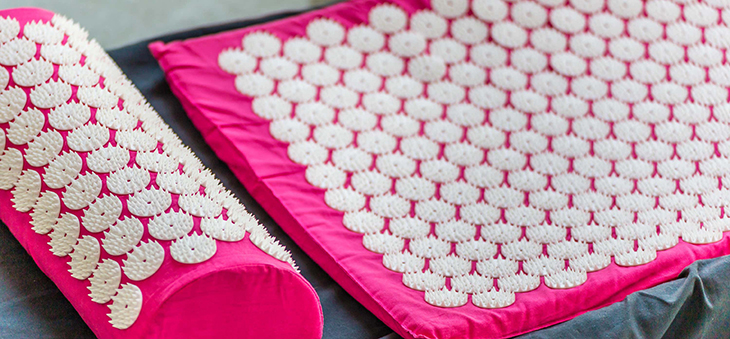Many of us are looking for new techniques to beat general aches and pains. One rather unusual way to alleviate strains is by using an acupressure mat – a foamy wellness tool that’s covered in hundreds of tiny plastic spikes.
Also known as a ‘bed of nails’ mat, the bizarre trend has gained steam in recent months, thanks to celebrity fans like Elle Macpherson, Jennifer Lopez and Kate Beckinsale.
And while it might sound like a medieval torture instrument, converts of the home treatment say that regular sessions on the sawtooth mats can help with pain, injuries, relaxation and sleep.
How does it work?
An acupressure mat looks a lot like a yoga mat, but the main difference is its covered in several hundred tiny, plastic spikes. These small nubs deliver pressure to parts of the body, which is said to bring on feel-good health benefits.
Acupressure itself is nothing new; it’s a traditional Chinese medicine technique that’s been around for centuries, and is usually performed by a practitioner who uses their fingers to firmly press onto key points around the body, to stimulate pain relief and muscle relaxation.
Read more: How traditional Chinese medicine can boost health and wellbeing
The mat works in a similar way. As you lie on the surface, the plastic spikes press into your body and cause the brain to release endorphins – euphoric chemicals that naturally relieve stress, tension and pain.
The main difference is that acupressure mats stimulate many acupressure points indiscriminately, as opposed to targeted acupressure or acupuncture treatments provided by a professional.
What are the benefits?
Anecdotally, people claim that the mats can reduce stress, improve sleep, deliver energy, soothe headaches, support circulation and beat back pain.
Much like foam rollers and other self-myofascial release tools, the mats use pressure to release muscle tension and improve blood flow around the body.
However, there’s very little scientific evidence to support the benefits of acupressure mats, although one small 2011 study said they could be a helpful tool for relaxation.
Our verdict
You’re probably wondering if lying against one of these mats hurts. The short answer is yes, but it’s a strangely pleasant pain that gets easier and more satisfying the longer you’re on it.
I tried out the Bed of Nails mat. Since their spikes can be sharp, the company suggests beginners shouldn’t lie on these mats with bare skin, so I start my first session with a pair of pyjamas on.
Read more: ‘Psychological acupressure’ technique grows in popularity
Lying back is a bit like lowering yourself into a bath that’s a bit too hot, and it takes a while to get used to the sensation, so I’d recommend breathing deeply and having the TV on in the background to distract you from the pain.

After a while, though, I really start to enjoy the zingy feeling of the spikes digging into every part of my shoulders and upper back – an area where I regularly hold a lot of tension. I soon notice that the sharpness of the spikes gradually fades and I feel relaxed, calm and sleepy instead.
Initially, it’s a good idea to lie on the mat for 10 minutes, and as you get used to the pressure, you can build up to 20-30 minute sessions instead.
As well as lying on it, Bed of Nails says you can gently place your feet on the mat to release foot tension too, and you can wear socks if you’re sensitive to the pain. Plus, you can also buy acupressure pillows that can be used along with the mat to help alleviate neck pain and headaches.
Read more: Nine ways to get (almost) instant relief from headaches
Overall, I definitely saw a reduction in my desk-induced aches and pains, and I feel I slept better too. While the Bed of Nails mat isn’t cheap, there are more budget-friendly alternatives on the internet, so you don’t necessarily need a celebrity salary to put the trend on trial.
Considerations
Mat spikes can pierce the skin, especially when the mats are used incorrectly. To avoid wounds or infection, don’t use an acupressure mat if you have thin skin, diabetes, or poor circulation.
- Most acupressure mat manufacturers don’t recommend using them while pregnant.
- Babies, toddlers, and small children should not use acupressure mats.
- If you have high or low blood pressure, talk to your doctor before using.
- Acupressure mats shouldn’t be used instead of medical treatments or prescribed medications.
Have you ever tried acupressure or acupuncture? Do you suffer with back pain or headaches?
– With PA
If you enjoy our content, don’t keep it to yourself. Share our free eNews with your friends and encourage them to sign up.
Disclaimer: This article contains general information about health issues and is not advice. For health advice, consult your medical practitioner.

